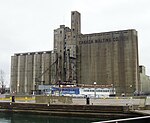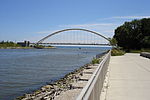Maple Leaf Stadium
1926 establishments in Ontario1967 disestablishments in OntarioAmerican football venues in CanadaChapman and Oxley buildingsDefunct baseball venues in Canada ... and 9 more
Defunct minor league baseball venuesDefunct sports venues in CanadaDefunct sports venues in TorontoDemolished buildings and structures in OntarioDemolished sports venuesPages with non-numeric formatnum argumentsSports venues completed in 1926Sports venues demolished in 1968Toronto Maple Leafs (International League)

Maple Leaf Stadium was a jewel box-style baseball stadium in Toronto, Ontario, Canada, located at the foot of Bathurst Street on the south side of Lake Shore Boulevard (formerly Fleet Street). It was built in 1926 by Lol Solman for his Toronto Maple Leafs baseball team of the International League. Previously, the Maple Leafs had played at Hanlan's Point Stadium. It continued to be the home of the Leafs for 42 seasons, until the team left town following the 1967 season. The stadium was demolished in 1968. Fans often referred to the stadium as the "Fleet Street Flats".
Excerpt from the Wikipedia article Maple Leaf Stadium (License: CC BY-SA 3.0, Authors, Images).Maple Leaf Stadium
Bishop Tutu Boulevard, Toronto
Geographical coordinates (GPS) Address Nearby Places Show on map
Geographical coordinates (GPS)
| Latitude | Longitude |
|---|---|
| N 43.635261111111 ° | E -79.400222222222 ° |
Address
Harbourside Co-operative Homes
Bishop Tutu Boulevard
M5V 1B3 Toronto
Ontario, Canada
Open on Google Maps










